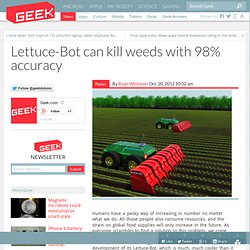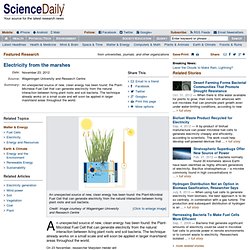

How many plants would you need to generate oxygen for yourself in an airlock? Unlocking the fractal patterns in cauliflower. Lettuce-Bot can kill weeds with 98% accuracy. Humans have a pesky way of increasing in number no matter what we do.

All those people also consume resources, and the strain on global food supplies will only increase in the future. As everyone scrambles to find a solution to this problem, we come back to one of our favorite problem-solvers: robots. Flowers in Ultra-Violet. The compilation of species will continue to be updated at irregular intervals.

All species listed here have been documented, and links are added whenever I can find spare time for updating. These images are made for illustrative purposes, not as artistic statements per se. However, there are lots of food for thought in the convoluted ways Nature expresses itself, so for once the artist can step backand let the subjects speak for themselves. "Das Ding an Sich" to paraphrase Kant, or Eigenvalue of Nature. If you are unfamiliar with the botany, just select any species indicated as having a "strong" response to learn how this looks. Mediadesk - New fossils push the origin of flowering plants back by 100 million years to the early Triassic. News release, October 01, 2013 Drilling cores from Switzerland have revealed the oldest known fossils of direct ancestors of flowering plants.

These beautifully preserved 240-million-year-old pollen grains are evidence that flowering plants evolved 100 million years earlier than previously thought, according to Rsearchers from the University of Zurich. Flowering plants evolved from extinct plants related to conifers, ginkgos, cycads, and seed ferns. The oldest known fossils from flowering plants are pollen grains. These are small, robust and numerous and therefore fossilize more easily than leaves and flowers.
Flowers Communicate with Electricity. Electricity from the marshes. An unexpected source of new, clean energy has been found: the Plant-Microbial Fuel Cell that can generate electricity from the natural interaction between living plant roots and soil bacteria.

The technique already works on a small scale and will soon be applied in larger marshland areas throughout the world. On 23 November, researcher Marjolein Helder will defend her PhD research on generating electricity via plants at Wageningen University, part of Wageningen UR. She has also founded a spin-off company called Plant-e with her colleague David Strik. The Plant-Microbial Fuel Cell draws electricity from the soil while the plants continue to grow. Plants produce organic material via photosynthesis. The Plant-Microbial Fuel Cell can currently generate 0.4 Watt per square metre of plant growth.
Marshlands Plant-Microbial Fuel Cells can be used on various scales. Biologists learn how plants synthesize their growth hormone auxin. Biologists at the University of California, San Diego have succeeded in unraveling, for the first time, the complete chain of biochemical reactions that controls the synthesis of auxin, the hormone that regulates nearly all aspects of plant growth and development.

Their discovery, detailed in a paper in this week's online edition of the Proceedings of the National Academy of Sciences, will allow agricultural scientists to develop new ways to enhance or manipulate auxin production to improve the growth and yield of crops and other plants. Inside Insides. What do fruits and vegetables look like inside an MRI? Short answer: "Whoa.". Scientists invent transparent soil to reveal the secret life of plants.
Lettuce grown in transparent soil developed by researchers at the James Hutton Institute and the University of Abertay Dundee in Scotland Most people’s image of plants is actually upside down.

For most of our photosynthetic friends, the majority of the plant is underground in the form of an intricate system of roots. The bit that sticks up is almost an afterthought. That’s a problem for scientists trying to study plants because growing them in media that allow you to see the roots, such as hydroponics, doesn't mimic real soil very well. Plants and fungi play the 'underground market'
Science 12 Aug 11 Micrograph of fungi colonising roots of plant host, Medicago truncatula.

Image: Jan Jansa Plants and fungi co-operate and trade with each other on a biological ‘underground market’, changing their trading partners if they don’t get a fair deal. The finding was made by an international team, including Oxford University scientists, examining how plants trade energy-rich carbohydrate they make using photosynthesis for phosphorus fungi collect from the soil. Plants may be able to 'hear' others - life - 08 June 2012. THEY can "smell" chemicals and respond to light, but can plants hear sounds?

It seems chilli seeds can sense neighbouring plants even if those neighbours are sealed in a box, suggesting plants have a hitherto-unrecognised sense. Plants are known to have many of the senses we do: they can sense changes in light level, "smell" chemicals in the air and "taste" them in the soil (New Scientist, 26 September 1998, p 24). Harnessing Plant-Invading Fungi for Fuel. This Behind the Scenes article was provided to LiveScience in partnership with the National Science Foundation.

As gas prices rise around the world, researchers are seeking a potential solution from endophytic fungi — fungi that live inside plants. While conducting a study on endophytes and their unique products, Gary Strobel of Montana State University and his fellow researchers made a discovery that could very well change our future fuel sourcing. In a recent study, published in the journal Microbial Ecology, Strobel and his team looked closely at an endophyte known as Hypoxylon, identifying the volatile organic compounds that it produces as well as its antimicrobial activity and genetic makeup.
Hypoxylon and similar fungi are common in tropical and semitropical plants and the volatile organic compounds they produce may be useable as fuels or fuel additives. Researchers trick plants into growing without sunlight. You’re probably aware that plants rely on the sun to power photosynthesis and supply the plant with energy. The other side of that is that plants have evolved to control their development steps based on exposure to sunlight. Knowing this, researchers at the Karlsruhe Institute of Technology have taken the first steps toward controlling plant development and creating plants that can grow in the dark.
Plants rely on photoreceptors to trigger various stages of growth. Everything from germination, to leaf production, to flowering is triggered by photoreceptors. Logy Magazine. Atmospheric oxygen really took off on our planet about 2.4 billion years ago during the Great Oxygenation Event.

At this key juncture of our planet’s evolution, species had either to learn to cope with this poison that was produced by photosynthesizing cyanobacteria or they went extinct. It now seems strange to think that the gas that sustains much of modern life had such a distasteful beginning. So how and when did the ability to produce oxygen by harnessing sunlight enter the eukaryotic domain, that includes humans, plants, and most recognizable, multicellular life forms? How the first plant came to be. The genome of provides essential clues to the origin of photosynthesis in algae and plants. Science/AAAS Earth is the planet of the plants — and it all can be traced back to one green cell. Plants that shut out bacterial invaders. I have a soft-spot for plant biology.
In my final year at university, having exhausted all of the bacteria-related biochemistry lectures, I took a bacteria-related lecture course with the plants department. It was a smaller department, and seemed a lot friendlier and nicer. Also the biscuits in the tea-room were cheaper. Plants Use Body Clocks to Prepare for Battle. By Olivia Solon, Wired UK Biologists at Rice University have discovered that while plants might look fairly inactive in the day, they are surreptitiously preparing for battle with hungry insects. [partner id="wireduk"]“When you walk past plants, they don’t look like they’re doing anything,” said Janet Braam, one of the investigators on a new study, which appears in the Proceedings of the National Academy of Sciences.
“It’s intriguing to see all of this activity down at the genetic level. Steroids control gas exchange in plants. Public release date: 5-Feb-2012 [ Print | E-mail Share ] [ Close Window ] Contact: Zhiyong Wang zywang24@stanford.edu Carnegie Institution Stanford, CA— Plants leaves are sealed with a gas-tight wax layer to prevent water loss. MIT creates solar cell from grass clippings.
A researcher at MIT, Andreas Mershin, has created solar panels from agricultural waste such as cut grass and dead leaves. In a few years, Mershin says it’ll be possible to stir some grass clippings into a bag of cheap chemicals, paint the mixture on your roof, and immediately start producing electricity. Amazonian Mushroom Eats Indestructible Plastics. First plants caused ice ages, new research reveals. New research reveals how the arrival of the first plants 470 million years ago triggered a series of ice ages. Led by the Universities of Exeter and Oxford, the study is published in Nature Geoscience. The team set out to identify the effects that the first land plants had on the climate during the Ordovician Period, which ended 444 million years ago.
Lichens. Nitrogen fertilizers' impact on lawn soils. Nitrogen fertilizers from farm fields often end up in aquatic ecosystems, resulting in water quality problems, such as toxic algae and underwater 'dead zones'. There are concerns that fertilizers used on lawns may also contribute to these problems. All of the lawns in the United States cover an area almost as large as Florida, making turfgrass our largest 'crop' and lawn fertilizer use a legitimate issue. In a study funded by the National Science Foundation Ecosystem Studies and Long Term Ecological Research programs, researchers from Cornell University and the Cary Institute of Ecosystem Studies have utilized recent technological advances to measure gaseous nitrogen emissions in home lawns.
In the past, scientists have conducted nitrogen input-output studies on lawns to determine how much nitrogen is taken up by vegetation or deposited in soils, and how much is lost. Nitrogen Fixation. All he is saying, is give pee a chance. How the waste was won – a new pop-up restaurant for the Melbourne Food and Wine festival, which combines art, food and ecology, is about creating a sustainable world. Earliest known bug-repellant plant bedding found at South African rock shelter.
Are the tables turning in the war between pests and genetically modified crops? Pests Are Developing Resistance to Monsanto's Engineered Supercorn. Some consumers may have a problem with genetically modified food crops, but in at least one case described in an Iowa State University researcher's paper there's one customer that's happy to consume Monsanto's GM corn: rootworms, the very pest the corn is modified to thwart.
According to the paper, western corn rootworms in at least four northeast Iowa corn fields have developed a resistance to the natural pesticide in corn seed produced by Monsanto, marking the first time a major Midwest pest has developed a resistance to GM crops. That could spell all kinds of trouble for food crops, farmers, Monsanto, and pretty much everyone who isn't a western corn rootworm. Though based on isolated cases thus far, the problem could be more widespread, and the paper is bound to rouse another debate on the benefits and demerits of GM crop cultivation and current farm management practices. Breaking News: Monsanto To Face Biopiracy Charges In India. The ISME Journal - Endogeic earthworms shape bacterial functional communities and affect organic matter mineralization in a tropical soil.
Honeybee deaths linked to seed insecticide exposure. Plants create a water reserve in the soil. No sun, no problem: scientists discover dark secrets of the plant world. If plants generate magnetic fields, they’re not sayin’ Leafy social network: Scientists study how stomata communicate. Plants Clean Up More Air Pollution Than Previously Thought. Newly Discovered Plant Bows Down and Buries Its Own Seeds. Scientists Discover First Night-Flowering Orchid : The Two-Way. Do Plants Have Minds? : 13.7: Cosmos And Culture. Key mechanism that regulates shape and growth of plants discovered. Tiny protein helps bacteria 'talk' and triggers defensive response in plants. Manipulating plants' circadian clock may make all-season crops possible. Discovery on how sugars are moved throughout a plant. Agriculture. What You Eat Affects Your Genes: RNA from Rice Can Survive Digestion and Alter Gene Expression.
Home Page: NCAT Sustainable Agriculture Project. Digital inventory of medicinal plants underway in Pune - Mumbai. Organisms. Urban Physic Garden. Guide to Common Edible Wild Plants. Experimental Recipes with Azolla, Super Plant (and Future Space Food?) 7 Edible Weeds - Article. Strawberries Protect The Stomach From Alcohol.
5 Ridiculous Myths People Use to Trash Local Food. Plant Teacher - Entheogens and Healing Herbs. Dutch PlantLab Revolutionizes Farming: No Sunlight, No Windows, Less Water, Better Food. PlantLab. Purple lights and math help PlantLab grow food more efficiently. Horticulture Discotech: LED Grow Lights Power Sustainable Farming.
Why the hottest chilies grow in the wettest places. Anthropology in Practice. Tip of the Tongue: The 7 (Other) Flavors Humans May Taste.